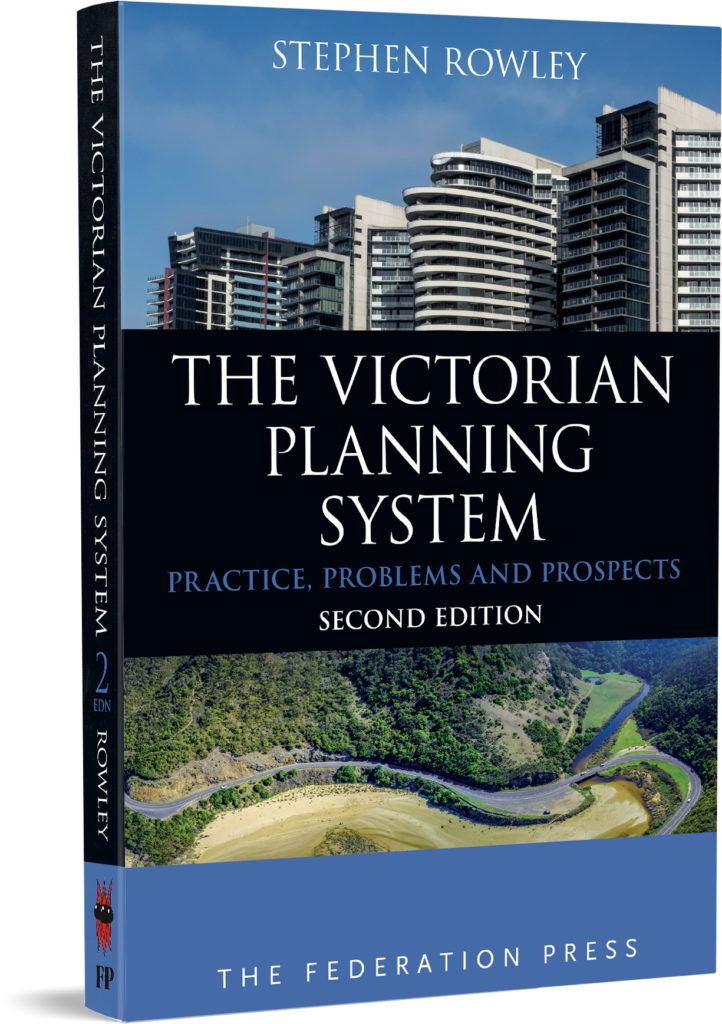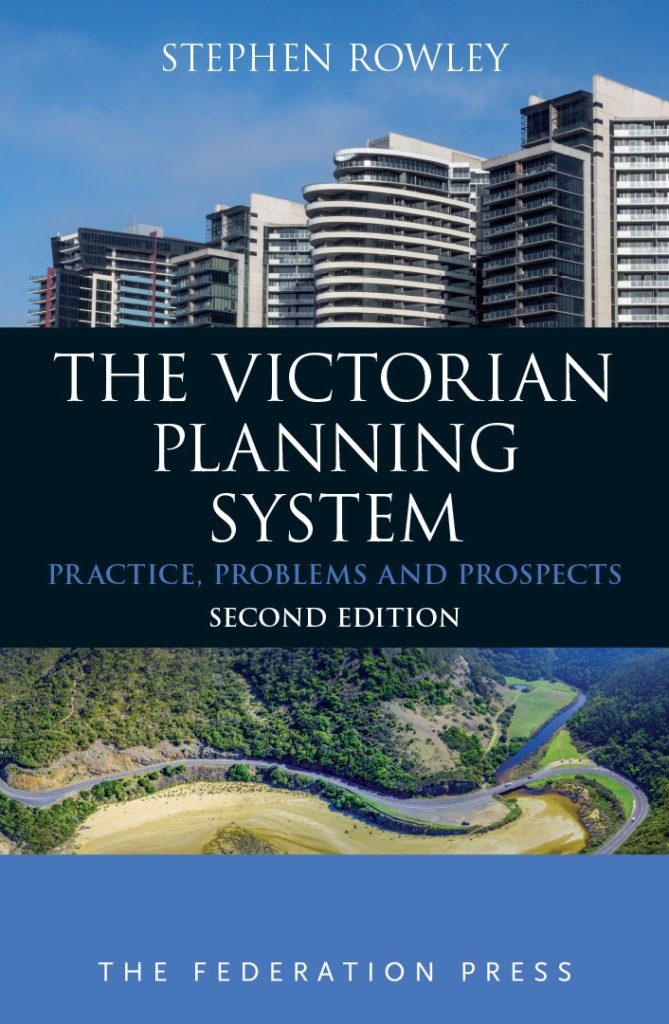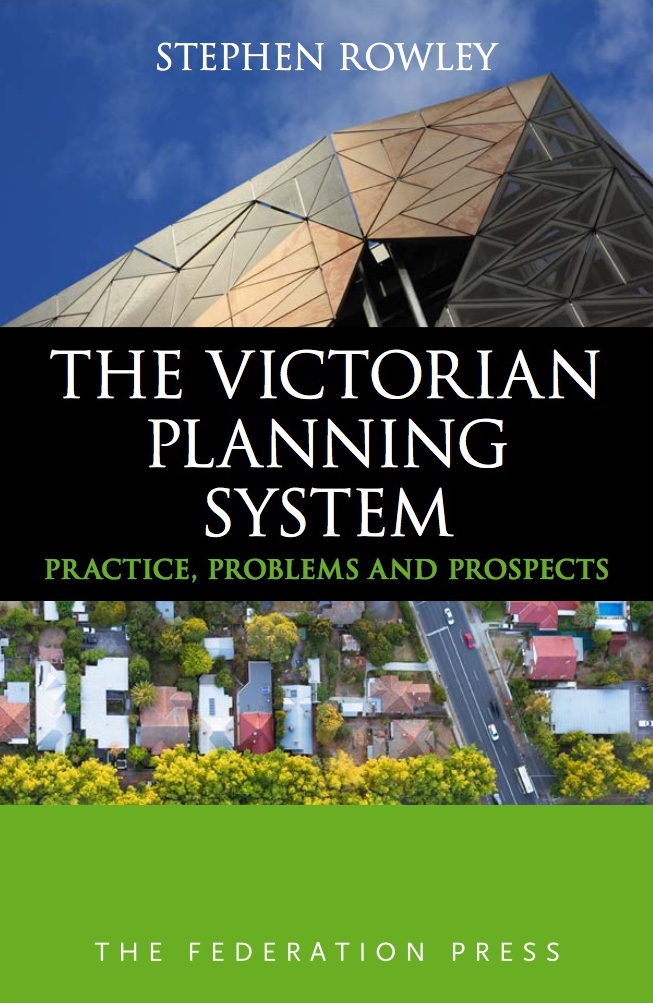Dr Rowley’s book provides a comprehensive overview of our Victorian planning system that clearly and simply covers the most difficult of topics in planning. This book should be essential reading for anyone with an interest in planning. It aids us in explaining why our system is the way it is – for better or worse – and assists in our continual advocacy for shaping a better society and future for all Victorians.
From the Foreword to the second edition by the Hon. Richard Wynne, Minister for Planning 2014-2022
My second book, The Victorian Planning System: Practice, Problems and Prospects, was released in January 2017. (For my first, see here: Movie Towns and Sitcom Suburbs: Building Hollywood’s Ideal Communities). In November 2017 it received a commendation from the Planning Institute of Australia (Victorian) at the annual planning awards, in the Cutting Edge Research and Teaching category.
The second edition is now available – see ordering options at the bottom of the page.
The book is intended intended as an introduction for new planners and the wider public who need to deal with the planning system (including residents, developers, councilors, and others). For established planners, it considers how our system functions to achieve policy objectives and outlines how it could be improved.
Here’s the publisher’s blurb:
The Victorian Planning System: Practice, Problems and Prospects is an accessible introduction for all those who use the Victorian planning system, including planners, lawyers, councillors, developers, design professionals and community advocates. It explains key terminology and processes in simple terms and explores how the planning system is used to pursue policy goals. This discussion is contextualised through examination of a variety of planning policy challenges, including housing affordability, activity centre planning, and climate change.
This second edition has been comprehensively revised and updated to address changes since 2017. These include the finalised Plan Melbourne 2017-2050, the “Smart Planning” program, integrated Planning Policy Framework, revisions to residential development provisions (including the Better Apartments Design Standards), and the new Environment Protection Act, among others. Other new or heavily revised content includes discussion of planning in growth areas, biodiversity offsetting for native vegetation removal, and Aboriginal heritage.
This edition also includes reconceived discussion of decision-making and regulatory design. It reviews the history of planning system reform in Victoria and explores why the system is still not as effective, efficient or transparent as it should be. In response, the book outlines a vision of a new planning paradigm that is more capable of achieving bold policy goals. It is essential reading for all Victorian planning professionals.
The book is structured around exploration of a variety of urban policy challenges, including housing supply, activity centre planning, heritage and environmental issues. How does planning strategy in these areas translate into action? Too often, the way that the planning system achieves on-the-ground outcomes is glossed over. This book aims to remedy that oversight by exploring the realities of policy implementation through regulatory design. In doing so, it offers a critique of the Victorian system, and suggests ways in which it could more effectively achieve visionary policy goals.
A key theme of the book is that the common separation between so-called “statutory planning” and “strategic planning” is counterproductive, and that planners need a more integrated approach to regulatory design. The book is therefore structured around a discussion of how the regulatory system responds to various policy dilemmas.

Dr Stephen Rowley’s book demystifies the planning system in accessible language and with an engaging narrative. Students, practitioners and citizens consulting this volume will be duly empowered to make the most of a system, which, for all its foibles, remains a powerful force shaping our lives.
From the Foreword to the first edition by Marcus Spiller
Introduction: Urban Planning and the Regulatory Challenge
The introduction considers the aversion amongst both the general public and urban planners to dealing with the regulatory planning system. It places this in historical context, and considers the way that the link between policy formulation (or strategic planning) and application assessment (statutory planning) can be more constructively conceived.
Chapter 1: Building Blocks of the Victorian Planning System
An overview of the structure of the Victorian system, covering key legislation, the main institutional “players,” and the structure and operation of planning schemes. Written in simple and accessible language, this chapter provides an entry for those unfamiliar with the system.
Chapter 2: Planning Permits and the Application Process
This chapter covers most people’s first interaction with the planning system, the planning permit application process. It steps through the stages in assessment, including discussion of why the process often takes so long. It also describes the structure of a typical planning permit.
Chapter 3: Planning Decisions and System Design
This chapter starts with a detailed discussion of how planning decisions are made, including contentious areas such as the consideration of social and economic effects, the role of policy, the relevance of the number of objections, and the so-called “National Trust principle.” The latter section of the chapter considers how the system is designed to guide these decisions. It defines different types of planning controls and considers the merits of the approach to regulatory design used in Victoria. This chapter has been considerably revised for the second edition, with a reconceptualised framework for the system design discussion and new discussion of good decison-making.
Chapter 4: Planning Appeals
This chapter gives a detailed explanation of the process of appealing planning decisions at the Victorian Civil and Administrative Tribunal (VCAT). It runs step-by-step through the appeal process and discusses how hearings are conducted. It also considers the role of the Tribunal, including issues of legalism, cost of access, community perceptions of pro-development bias, and the place of an appeals Tribunal in a democratic system.
Chapter 5: Complications
In order to keep the opening chapters as straightforward as possible, various special cases and detailed issues are considered separately in this chapter. Issues covered included code assessment, VicSmart, applications by government, covenants, amendments to permits (including secondary consent), cancellation of permits, and planning enforcement.
Chapter 6: Amending Planning Schemes
This chapter considers how the content of planning schemes is formulated and amended. It steps through the planning scheme amendment process and discusses the role of councils, the Department, planning panels, and the Minister. It discusses challenges around the amendment process including timeliness and the adequacy of strategic justification.
Chapter 7: Shops and Houses
This discussion considers the way that strategy is implemented through the planning system. In particular, the chapter looks at issues of activity centre policy and efforts to focus and direct residential growth. The implementation of Plan Melbourne 2017 is discussed in detail. The operation of the residential development provisions is discussed in depth, including the so-called ResCode provisions and the Better Apartments Design Standards.
Chapter 8: Planning and the Environment
This chapter explores how the planning system manages environmental issues. This includes a discussion of the environmental impact assessment (environment effects statement) regime, and the new Environment Protection Act 2017. Planning schemes’ treatment of environmental issues is also discussed using several issue-based case studies: the treatment of sustainable building controls, native vegetation removal, and the response to hazards from climate change such as costal inundation and bushfire.
Chapter 9: Quandaries
Further issues-based examples of how the system functions are included in this chapter. These include discussion of controls around heritage, various contentious entertainment uses (including brothels, pokies, licensed premises, live music venues, and fast food restaurants) and car parking.
Conclusion: System Review and Reform
The conclusion surveys the history of system reform in the VPP era, and pulls together arguments that are weaved through the remainder of the book to seek to explain why the system still struggles to live up to its potential.
Other material
The book includes a glossary, a guide for further reading, index, and copious footnotes to assist the interested reader in seeking further information
Links
Booktopia listing (second edition).


